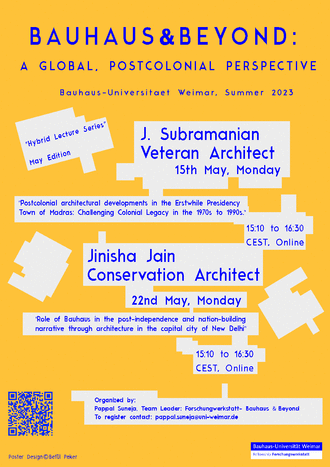
"Role of Bauhaus in the post-independence narrative through architecture in New Delhi" by Jinisha Jain
Click the Play button to load and view external content from Vimeo.com.
Automatically load and view external content from Vimeo.com (You can change this setting at any time via our »Data protection policy«.)
Mondays, 3:10 pm to 4:30 pm CEST via Big Blue Button, Moodle.
22nd May 2023 - "Role of Bauhaus in the post-independence and nation-building narrative through architecture in the capital city of New Delhi" by Jinisha Jain, Conservation Architect.
As the Bauhaus school was closed in 1933, many former students and teachers fanned out of Germany to spread the ideas, architecture, and ethos of 'The Bauhaus' to the rest of the world, including former British India, among other countries. Early academic study in India was largely based on Western ideologies and European aesthetics and techniques. At the same time, it consciously strives to look beyond the Colonial British Precedent. Some young architectural students made their way overseas. Amongst them were Achyut Kanvinde and Habib Rehman who were taught by Walter Gropius (founder of the Bauhaus, 1919) in the USA and they were instrumental in bringing the Bauhaus ideology to the capital city of New Delhi in several significant public new buildings that the seminar shall throw light on.
15th May 2023 - "Postcolonial architectural developments in the Erstwhile Presidency Town of Madras: Challenging Colonial Legacy in the 1970s to 1990s." by Jayaraman Subramanian, Veteran Architect.
The seminar will briefly touch upon the Architecture of India during the Precolonial period, also which was predominantly Indo-Islamic followed by Moghul. When the British came to India, they started building several public buildings such as courts, corporate houses, administrative offices, etc. - relatively a new typology - in colonial, neo-classical, Indo-Saracenic, and Art Deco styles; particularly in Chennai (the then Madras) where I spent my formative years and also studied architecture (1960 - 1965). There were few schools of architecture in the region and also access to information and knowledge which was mostly limited to teachers and libraries. I was particularly influenced by the works and philosophy advanced by some of the great Masters like Mies Van der Rohe, Pierre Luigi Nervi, Eero Saarinen, Philip Johnson, and Walter Gropius; which were punctuated by the integrity of expression (through the fusion of Art & Technology) resulting in a new grammar of aesthetics that was refreshingly different from what were and was happening around. This also affected developments in other parts of the country through architects like Corbusier, Kanvinde, Charles Correa, Raj Rewal, Louis I. Kahn, etc., In my talk, I shall present some of my major works done during this period (1970 - 1990) in India that will bear evidence of these influences.

"Postcolonial architectural developments in Madras: Challenging Colonial Legacy in 1970-1990s." by Jayaraman Subramanian
Click the Play button to load and view external content from Vimeo.com.
Automatically load and view external content from Vimeo.com (You can change this setting at any time via our »Data protection policy«.)

India-UK: Decolonial Relations & Dilemmas by Megha Rajguru
Click the Play button to load and view external content from Vimeo.com.
Automatically load and view external content from Vimeo.com (You can change this setting at any time via our »Data protection policy«.)
19th June 2023: "India-UK decolonial relations and dilemmas" by Megha Rajguru, University of Brighton, UK.
This talk will address how the design was used as a mechanism to frame independent India's cultural prowess by the state and various cultural actors in the 1950s, while simultaneously being used as a vehicle for social and economic development by a range of stakeholders, including organizations and designers. Here the conflict between the past and present played out, unfolding recurrent dilemmas of presenting heritage in relation to modernity.
12th June 2023: “Neo-colonial Architecture in the Indian Context - a glimpse of Jaisim-Fountainhead” by Krishna Rao Jaisim, Bengaluru.
When I studied architecture (the mid-1960s) I was influenced by 'THE FOUNTAINHEAD' and St. Petersberg City in Russia which followed the then-great projects by the most influential architects of the Colonial World. At this time I got to learn from Prof. K. N. Iyengar teaching me the History of Architecture, who introduced me to the great Mies van der Rohe of the BAUHAUS and his fascinating works. The discipline of Symmetry and the balance in structure and art, playing with spaces by hierarchy were a challenge that only few professionals could master. I was fortunate to study the many examples that still exist and function today and for eternity. Materials and Technology were limited in that era. The present century has now opened up the visualization and realization into limitless forms and functions, only limited by imagination. I have taken this road to my architecture of expression. Keeping Grammar and Rhetoric alive and communicating to the world of creative architectural expression. Architecture by any architect is a story, the building plays with the Human Mind and Senses and fuses with the Environment, Culture, and History of a People of the land that belong.


